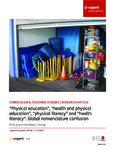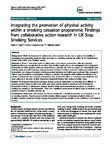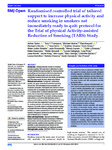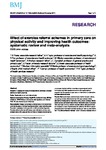"Physical education", "health and physical education", "physical literacy" and "health literacy": Global nomenclature confusion.
| dc.contributor.author | Lynch, TJ | en |
| dc.contributor.author | Soukup,, GJ | en |
| dc.date.accessioned | 2016-08-15T10:42:00Z | |
| dc.date.available | 2016-08-15T10:42:00Z | |
| dc.date.issued | 2016-08-05 | en |
| dc.identifier.issn | 2331-186X | en |
| dc.identifier.other | 1217820 | en |
| dc.identifier.uri | http://hdl.handle.net/10026.1/5298 | |
| dc.description.abstract |
The title “physical education” (PE) is the traditional taxonomy used to represent the education discipline. Health and physical education (HPE) is regarded to be an all-encompassing health-dimensional title that has been recently embraced by various education systems around the world. Hence, it can be argued that PE and HPE are often used interchangeably by educationalists, portraying a similar meaning and understanding. This can be regarded as internationally confusing, as historically PE and HPE have represented different and at times paradoxical discourses and ideologies. Amongst the ambiguity of which title to use, PE or HPE, new terms of branding such as “physical literacy” and “health literacy” have re/emerged. The purpose of this interpretivist study is to identify if associated terms used for the original PE label are a help or hindrance to practitioners? Participants were asked an open-ended question relating to PE nomenclatures. The data gathered were analysed and findings confirmed that practitioner confusion does exist. It is suggested that children are first and foremost “physically educated”; therefore a strong, clear and comprehensive grounding in quality PE is essential for teachers and students. | en |
| dc.format.extent | 1 - 22 | en |
| dc.language.iso | en | en |
| dc.publisher | Taylor & Francis | en |
| dc.subject | physical education | en |
| dc.subject | physical literacy | en |
| dc.subject | health | en |
| dc.subject | health literacy | en |
| dc.subject | health and physical education | en |
| dc.subject | curriculum improvement | en |
| dc.subject | holistic education | en |
| dc.subject | well-being | en |
| dc.subject | nomenclature | en |
| dc.subject | education policy | en |
| dc.title | "Physical education", "health and physical education", "physical literacy" and "health literacy": Global nomenclature confusion. | en |
| dc.type | Journal Article | |
| plymouth.author-url | http://www.timothylyncheducation.com/ | en |
| plymouth.issue | 1 | en |
| plymouth.volume | 3 | en |
| plymouth.publisher-url | http://cogentoa.tandfonline.com/full/10.1080/2331186X.2016.1217820 | en |
| plymouth.publication-status | Published | en |
| plymouth.journal | Cogent Education | en |
| dc.identifier.doi | 10.1080/2331186X.2016.1217820 | en |
| plymouth.organisational-group | /Plymouth | |
| plymouth.organisational-group | /Plymouth/Faculty of Arts, Humanities and Business | |
| plymouth.organisational-group | /Plymouth/Faculty of Arts, Humanities and Business/Plymouth Institute of Education | |
| dcterms.dateAccepted | 2016-07-25 | en |
| dc.identifier.eissn | 2331-186X | en |
| dc.rights.embargoperiod | No embargo | en |
| rioxxterms.versionofrecord | 10.1080/2331186X.2016.1217820 | en |
| rioxxterms.licenseref.uri | http://www.rioxx.net/licenses/all-rights-reserved | en |
| rioxxterms.licenseref.startdate | 2016-08-05 | en |
| rioxxterms.type | Journal Article/Review | en |
| plymouth.oa-location | http://www.tandfonline.com/doi/full/10.1080/2331186X.2016.1217820 | en |





